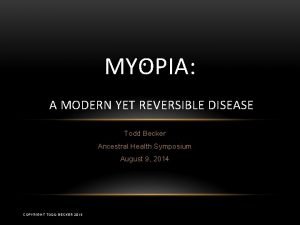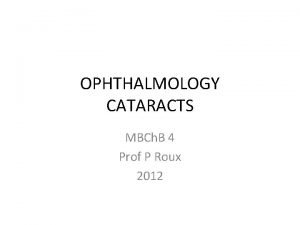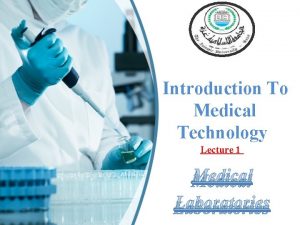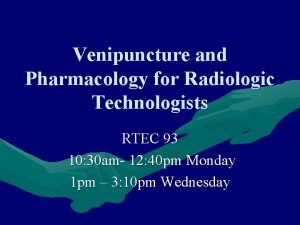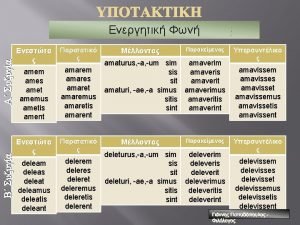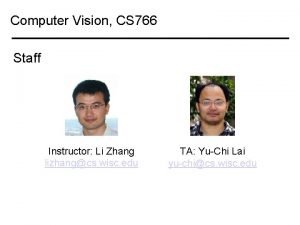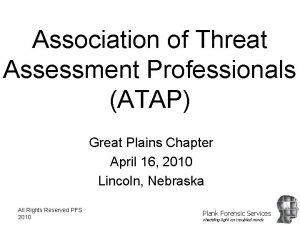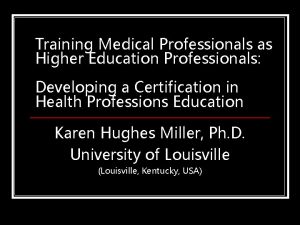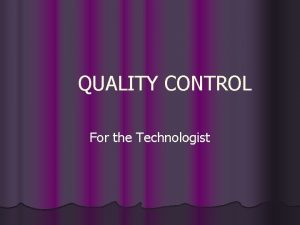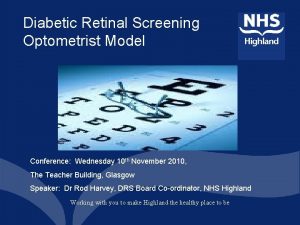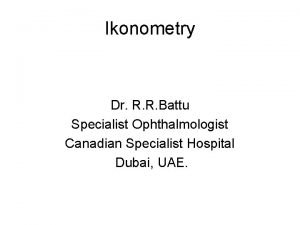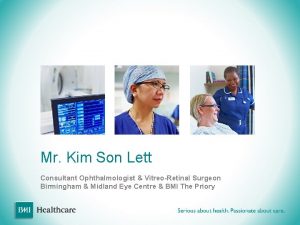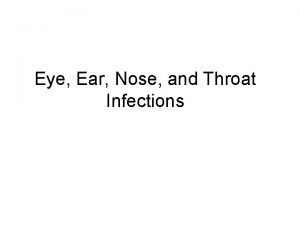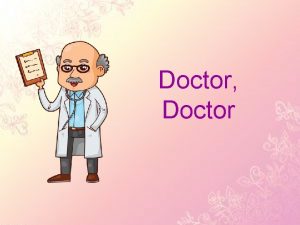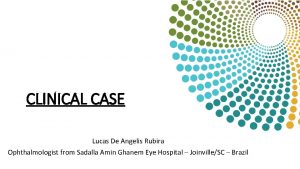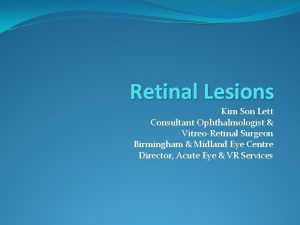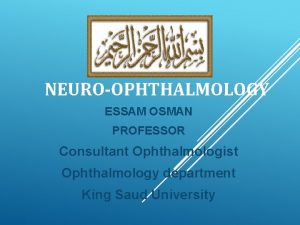Vision Care Professionals Ophthalmologist Optometrist Orthoptist Optholmic Technologist































- Slides: 31


Vision Care Professionals • • Ophthalmologist Optometrist Orthoptist Optholmic Technologist Opthalmic Technician Opthalmic Assistant Opthalmic Laboratory Technician Optician, dispensing

Ophthamologist • A medical doctor (MD) who is licensed to practice medicine and surgery. • May perform all duties of optometrist, but treats injuries and performs eye surgeries. • Education: 4 years undergraduate, 4 years graduate, 3 years minimum specialization in ophthamology.

Ophthamology Licensing • Individual state board of medical examiners • Additional board exams specific to ophthamology

Optometrist • Doctor of Optometry (O. D. )-had the title of doctor but is not a medical doctor. • Examines the eyes to diagnose vision problems and eye diseases. • Education: at least 3 years of preoptometric study, 4 -year doctor of optometry degree from an accredited optometry school.

Optometry Licensing • State board of optometry • American optometric Association

Anatomy of the Eye

Lens • Located just behind the iris. • Purpose: to focus light onto the retina.

• The opening in the center of the iris. • Size determines the amount of light that enters the eye. • Doctors often evaluate the reaction of pupils to light to determine neurological function.

Cornea • The transparent dome-shaped window covering the eye. (Gives us a clear window to look through. ) • Provides 2/3 of the eye’s focusing power.

Iris • The colored part of the eye. • Controls the light levels inside the eye. • Has tiny muscles that widen and narrow the pupil size.

Retina • A multi-layered sensory tissue that lines the back of the eye. • Capture light rays, convert them to electrical impulses, traveling to the brain where they are turned into images.

REFRACTION ERRORS: an error in the focusing of light by the eye and a frequent reason for reduced visual acuity. • Myopia • Hyperopia • Astigmatism

MYOPIA • “Nearsightedness” (spherical error)-optics are too powerful for the length of the eyeball.

• “Farsightedness “(spherical error) optics are too weak for the length of the eyeball.

Astigmatism • (Cylindrical error) Condition caused by an irregularly shaped cornea/results in blurred vision (optical power is too powerful or too weak across one meridian of the optics ).

Astigmatism

Presbyopia • loss of close reading vision due to a lessoned ability to focus and accommodateeyestrain/most develop in their 40’s. )

Amblyopia • Poor vision in one eye • Known as “Lazy Eye” • Usually results from inadequate use during early childhood.

Strabismus • One eye focuses properly, but the other eye strays. • “Cross-eyed” • Can be causes by genetics, inappropriate development of the “fusion center” in the brain to the muscles or nerves.

Glaucoma • Any disease caused by abnormally high pressure within the eye. • Treatment-eye medications or surgical procedures to relieve pressure. • If not treated, can lead to blindness.

Cataracts • Cloudiness of the lens of the eye (usually through aging process, but can be congenital or from disease or injury.

Conjuctivitis • “Pinkeye”-a highly contagious infectious inflammation of the conjuctiva. • Treatment-antibiotic eye drops or ointment.

Equipment • Ophthalmic Zoom Optical Head

Lensometer • An instrument to measure the power & cylindric axis of a spectacle lens. (Used to obtain an optical prescription. )

Optimal Prescription • A written order by an optometrist or ophthamologist to an optician for eyeglasses. • It specifies the refractive power to which the eyeglasses are to be made in order to correct blurred vision due to refractive errors, including myopia, hyperopia, astigmatism and presbyopia.


Prescription Terms • D. V. – “distance vision” (the part of the prescription designed primarily to improve far vision. ) • N. V. – “near vision” (may represent a singlevision lens prescription to improve near work, or the reading portion of a bifocal lens. ) Some forms use “ADD” in place of “N. V. with a single box to indicate the additional refractive power to be added to the spherical of each eye.

• O. D. (ocular dexter) – Latin for “right eye”. • O. S. (oculus sinister) – “left eye”. • O. U. (oculi uterque) – “both eyes”.

Spherical Correction • Corrects refractive error of the eye with a single convergent or divergent refractive power in all meridians.

• Corrects astigmatism refractive error of the eye by adding or subtracting power cylindrically in a meridian specified by the prescribed axis.
 Morgan white insurance premium
Morgan white insurance premium Getting stronger todd becker
Getting stronger todd becker Orthoptist music therapist
Orthoptist music therapist Drug rehab firth
Drug rehab firth Dominic mchugh ophthalmologist
Dominic mchugh ophthalmologist Shield cataract
Shield cataract Role of medical technologist
Role of medical technologist Cbne certification
Cbne certification Certified engineering technologist ontario
Certified engineering technologist ontario Neurodiagnostic technologist programs
Neurodiagnostic technologist programs Dennis food technologist
Dennis food technologist Venipuncture radiologic technologist
Venipuncture radiologic technologist Chief technologist
Chief technologist Levels of care primary secondary tertiary quaternary
Levels of care primary secondary tertiary quaternary Cs766
Cs766 Fepblue org mra/login
Fepblue org mra/login Atap threat assessment
Atap threat assessment Teachers etiquette professionals
Teachers etiquette professionals Focus on pharmacology essentials for health professionals
Focus on pharmacology essentials for health professionals Ethical guidelines for computer professionals
Ethical guidelines for computer professionals Solid
Solid Nursing english for pre-professionals
Nursing english for pre-professionals Mitc clock in
Mitc clock in Latin pro procurement professionals
Latin pro procurement professionals Extranet for security professionals
Extranet for security professionals Families professionals and exceptionality
Families professionals and exceptionality Ispe young professionals
Ispe young professionals Bruce a research chemist case study
Bruce a research chemist case study Allied health professionals
Allied health professionals Canadian registered safety professionals
Canadian registered safety professionals Ncsf kink aware professionals
Ncsf kink aware professionals Training for higher education professionals
Training for higher education professionals

